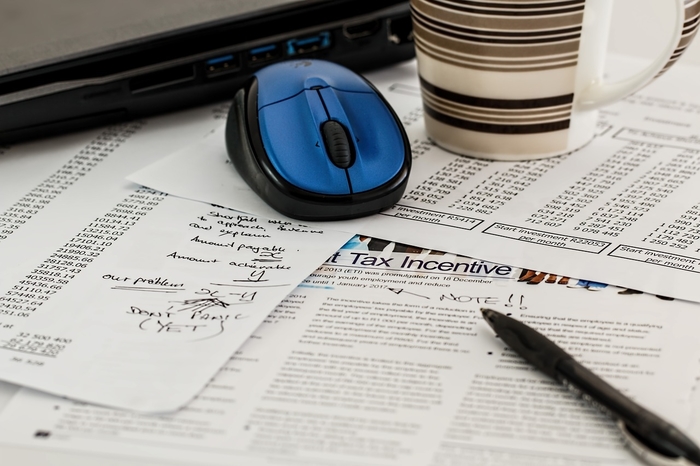 image source: Pixabay
image source: Pixabay
If you are a taxpayer, it is important to know which taxes you should pay to avoid charges of tax evasion, which is a criminal offense. As a citizen, you should remit taxes timely. However, there are certain types of taxes that should be withheld. The IRS withholds taxes from taxpayers for specific types of income for federal tax purposes. This is referred to as backup withholding, which may be mandatory in some occasions. You should note that most taxpayers are exempt from backup withholding. So what is backup withholding? This article highlights what is backup withholding, the need, and information on whether you are subject to backup withholding.
What Is Backup Withholding?
 image source: Pixabay
image source: Pixabay
According to the IRS, there are situations when a payer is required to withhold at the current rate of 24%. The 24% tax is taken from any future payments so that the IRS receives the tax due on the income. This is referred to backup withholding (BWH) and is required under two programs.
The first is under BWH-B program if you fail to provide a correct TIN to the payer for reporting on the required information return. A TIN can be an EIN, an SSN, or ITIN. The second program is BWH-C if you fail to report or under-report interest and dividend income you received on your federal income tax return. It also applies to you if you failed to certify that you are not subject to backup withholding for under-reporting dividends and interests.
How It Works
You need to know what is backup withholding and how it works. In general, the entity or employer that makes payments to the payee must withhold a percentage in federal income taxes from their payments. The employer needs to remit the withheld amount to the IRS, under Section 3406(b) of the Internal Revenue Code. However, the working relationship does not have to be employer/employee for backup withholding to apply.
It can also apply to independent contractors, landlords, brokers, freelancers, or anyone who receives royalties, interest, gambling winnings, or dividends. These people receive 1099 forms and may also find that the entities remitting payments to them are required to get backup withholding. Exceptions are foreclosures, real estate transactions, canceled debts, and abandonment.
The IRS typically makes the notification of backup withholding through CP2100A or CP2100 Notice. The notice comprises documents because of the taxpayer that have errors, including SSN, ITIN, or EIN, and informs the recipient that the URS will begin backup withholding.
Why Backup Withholding Matters
 image source: Pixabay
image source: Pixabay
To know what is backup withholding, you need to know why it matters. When you become an employee or conduct business with another entity, the entity or company should give you a Form W-9, which requests the taxpayer identification number and certification. The taxpayer should then enter the TIN on the form and certify that it is the correct one.
Most taxpayers are exempt from backup withholding if they provide the correct TIN information using the Form W-9. The information should, therefore, match the IRS records. When the taxpayer’s name or TIN does not match the IRS records or the taxpayer owes federal income taxes, the IRS will notify the taxpayer that he or she needs to have backup withholding.
The Significance of Backup Withholding
To know what is backup withholding, you need to be knowledgeable of its significance. Backup withholding ensures that the taxpayer remits the necessary taxes. Essentially, this helps to prevent instances of tax evasion. It is a measure imposed by the IRS so that you pay some of your taxes. It is sometimes mandatory. The purpose is mainly to ensure that the government can collect taxes on all appropriate income, and more particularly, income that is not subject to withholding, such as stock profits or interests.
For instance, when a bank pays you interest, the proceeds are reported to the IRS. The IRS then expects you to report that interest when you file your returns. If the bank does not have the correct SSN, it becomes impossible to tell the IRS who paid. The IRS in turn, does not know who to expect to pay the taxes on the interest payments. As such, backup withholding is a precautionary measure to ensure taxes are paid.
How Do You Know If You Are Subject to Backup Withholding?
To accurately know what is back up withholding and whether you are subject, you need to know payments subjected and exempted from backup withholding. The IRS requires financial institutions and businesses to withhold 24% of the following types of income reported on Forms W-2G and 1099:
- Dividends (Form 1099-DIV)
- Interest payments (Form 1099-INT)
- Third-party network transactions (Form 1099-K)
- Rents, profits, or other gains (Form 1099-MISC)
- Payments by fishing boat operators (Form 1099-MISC)
- Payments barter exchanges or by brokers (Form 1099-B)
- Gambling winnings may also be subject to backup withholding (Form W-2G)
- Royalties (Form 1099-MISC)
- Royalties (Form 1099-MISC)
- Royalties (Form 1099-MISC)
- Certain governmental payments, Form 1099-G
- Original issue discount reportable on (Form 1099-OID), Original Issue Discount, if the payment is in cash
- Patronage dividends, but only if at least half the payment is in money (Form 1099-PATR)
- Commissions, fees, or other payments for work you do as an independent contractor (Form 1099-MISC)
According to the IRS, the following payments are exempted from backup withholding:
- Canceled debts
- Foreclosures and abandonments
- Distributions from Archer MSAs
- Real estate transactions
- Distributions from any retirement account
- Long-term care benefits
- Fish purchases for cash
- Distributions from an employee stock ownership plan
- State or local income tax refunds
- Unemployment compensation
- Qualified tuition program earnings
When the IRS Requires Backup Withholding
The IRS requires employment entities and financial institutions to withhold tax when the taxpayer provides the wrong TIN in the required manner. The IRS then notifies the payer that the TIN is incorrect. The IRS will inform you it will withhold on dividends and interest because you under-reported dividends or interests on your income tax return. The IRS typically notifies you it will do this after it has mailed you four notices within 120 days. You are subject to backup withholding if you fail to certify that you are not subject to backup withholding for under-reporting of dividends and interests.
Prevention of Backup Withholding
Backup withholding due to incorrect TIN on Form W-9 can be prevented by providing the correct TIN and name on Form W-9 and certify that you are not subject to withholding. If the TIN and name provide in the W-9 do not match, the IRS will definitely send you “B” notice if income that alerts you that the TIN does not match IRS records. The income payer will send a copy of the notice to the recipient.
Once you receive this notice, which notifies you that the TIN you gave is incorrect, you can prevent backup withholding by providing the correct TIN and name to the payer. You should also certify that the TIN is correct. If the TIN and name still do not match the IRS records, the payer will receive a second “B” notice, which will be forwarded to you. Once you receive it, you should provide the payer with verification of your TIN from the IRS or Social Security Administration (SSA).
You can also prevent withholding due to under-reported dividends or interest. The IRS notifies the taxpayer by mailing four notices within 120 days to alert the taxpayer of future backup withholding. This is rectified by requesting and receiving a determination from the IRS. In the request, show that:
- You did not under-report
- Backup withholding will cause undue hardship and you will not under-report
- You have a bona fide dispute with the IRS on whether under-reporting occurred
- You have rectified the under-reporting by filing the original returns if you had not done so or present an amended one and pay the required taxes
Recovering the Amount of Backup Withholding
Any federal income that is withheld from your income owing to backup withholding should be reported to you and the IRS using the appropriate Form 1099, such as 1099-INT for interest income. You should then report the amount withheld when you file your returns.
Conclusion
If you are a taxpayer, you should know what is backup withholding and whether you are subject to withholding. However, know the types of income applicable to withholding, which include royalties, interest, rents, dividends, patronage dividends, payments from fishing boat operations or from stockbrokers and bond transactions, and fees and commissions paid to independent contractors. You are subject to backup withholding if you fail to provide a correct TIN to the payer for reporting on the required information return.
A TIN can be either an EIN, an SSN, or ITIN. You are also subject to withholding if you fail to report or under-report interest and dividend income you received on your federal income tax return. People who fail to certify that you are not subject to backup withholding for under-reporting dividends and interests are also subject to withholding. We hope that this article has adequately provided information on what is backup withholding and whether you are subject to withholding.